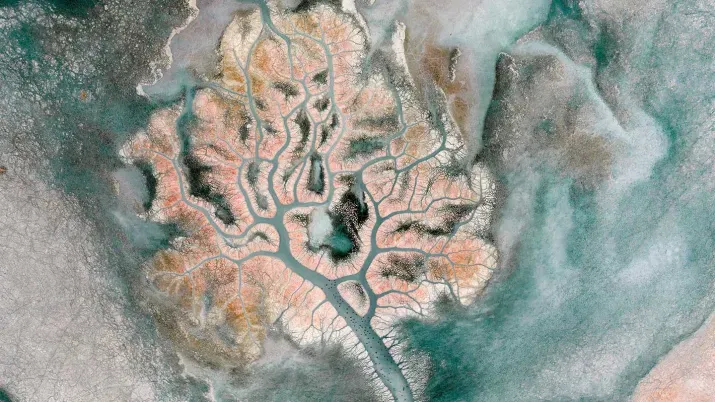Geopolitical terms: Vocabulary for a new world
Asset management
Do our words shape the world? Or does the world inform our words? This age-old philosophical question highlights the inextricably intricate relationship between our words and our realities. It’s therefore logical that, as our world shifts, so too do the words we use to speak about it.
Why is this important for investing? Let us give just one example: Investors tend to shy away from riskier assets, such as equities or high-yield bonds, when geopolitical risk rises, as these types of assets are more sensitive to price volatility. How can an investor make informed decisions if they don’t understand the key terms used to explain geopolitical risk?
Following our deep dive into the macroeconomic vocabulary – the terms that shape us – we’re continuing with an explainer on geopolitical terms. While by no means an all-encompassing catch-all list, it sheds light on some of today’s most common geopolitical terms, the meaning of new and emerging wording, and why some classic terms from the past need to be rethought, or even forgotten.
“Since China’s ascent as a new global power, the term geopolitics has become as important again as during the years of the Cold War. As investors, we need to be aware of the geopolitical shifts that could shake markets and asset prices and prepare for the trends that could turn out to become new realities.”
Geopolitics
With geopolitics, we refer to the power relationships on a global scale that span across topics like territorial disputes, resources, national interests and population management – and how each country, region or group attempts to reach their goals. It includes both diplomatic power disputes on a friendly level and confrontational power struggles, such as war. It can also take more abstract dimensions, such as religion or ideologies. Put simply, it entails everything that could shape – and reshape – the current and future global order. At a time when the world is facing renewed tensions between the global superpowers US, Russia and China, this term is likely to take on a more prominent role in the news in the foreseeable future .
Globalization
Perhaps the simplest way into the topic of geopolitics is to start with a look at globalization. Our world has become ever more interconnected and interdependent, affecting everything from trade and technology to migration, investment flows and information. In turn, these developments have also shaped the ideologies people hold, be they stances on the economy, society, or culture. To be sure, in the context of economics and financial markets, globalization is most commonly referred to when talking about trade. Global trade volumes have surged 4,300% between 1950 and 2021, according to the World Trade Organization . It is the very prospect of trade agreements, that played a huge role in sparking globalization and contributed to a growing network of international supply chains.
Proponents of globalization say that this has improved our lives significantly because it has boosted the world’s economy, helped create more jobs, and allowed companies to expand, manufacture at lower costs, and become more competitive on a larger scale. Globalization has made it possible for consumers to order an item from across the world and receive it within a few business days, while simultaneously offering them a much wider variety to choose from.
However , globalization has not always been globally embraced, with some arguing that it puts certain demographic groups at a distinct disadvantage. An argument in this direction are the disgraceful working conditions that exist in some parts of the developing world and exploit workers, while feeding products into global supply chains. Elsewhere, they argue many have lost their jobs due to outsourcing, facilitated imports, and migrant workers, and creates greater inequality among skilled and unskilled employees. All of this has led to the rise of nationalistic and populist stances – which will be explained below – among some politicians and voters who feel globalization has led to a disadvantageous situation.
Deglobalization
There’s also been some discussion about deglobalization, with certain groups in certain countries increasingly seeking local solutions and moving away from international treaties . While migration increased until the outbreak of the Covid-19 pandemic, foreign direct investments haven’t returned to the boom levels seen in the decades through 2008 and the global financial crisis.
The rise of nationalism and protectionism, which we explain further down, are further examples of deglobalization. Think of Brexit, which turned EU relations upside down, or former US President Donald Trump’s retreat from a number of treaties and alliances. The question of whether deglobalization is accelerating especially arose during the pandemic , as it highlighted the risks that accompany an interconnected global economy and its supply chains. Additionally, the war in Ukraine – and the embargoes and sanctions against Russia that came with them – can also lead to deglobalization, slowbalization or friend-shoring and a newbalization .
With the emergence of deglobalization trends, so have new terms.
Slowbalization
Some argue that deglobalization doesn’t accurately describe the current environment, and that rather, a term like slowbalization hits the nail on the head. If we look at the world’s recovery from the pandemic, some areas were faster to recover from the lockdowns, such as global migration and tourism. Some areas, such as the volume of global cross-border data transfers didn’t even budge downward during the pandemic. But other areas, like trade and logistics have been rebounding at a much slower pace . That’s partly because of labor shortages and shifts in demand. So, the term snowbalization argues that the globalization trends continue, just more slowly.
Newbalization
Others yet find newbalization better depicts the deglobalization trends. Rather than claiming that globalization has come to an end, they use this term to describe an evolved situation in which nations will likely rethink their trade, cross-border data exchanges, immigration policies and supply networks so as to ease their dependencies on individual countries and suppliers. This indicates more of a shift toward a new way of thinking of globalization , rather than the end of it, as there will be new countries that will benefit from these changes, like for example in the case of any increase in friend-shoring.
Friend-shoring
Friend-shoring occurs when countries focus or limit their supply-chain networks to allies and friendly countries. This helps nations protect their supply chains and reduce their dependence on nations they have tensions with. Earlier this year, US Secretary of the Treasury Janet Yellen mentioned friend-shoring in a speech that emphasized the importance of focusing on trade and investment within a group of countries that share similar values, which some interpreted as an attempt to sideline China.
Cold War
While this term refers to a period of political hostility and geopolitical tension between the Soviet bloc countries and the US bloc and its western allies from 1945 until the Soviet Union collapsed in 1991, the term has increasingly made a reappearance in recent years. It received the name as it didn’t involve any direct military action, neither group ever officially declared war on another – even as they did fight via proxy wars, such as in Vietnam and Afghanistan, and rather utilized the economy, politics, propaganda, and espionage in the conflict.
That leads us to another evolved term.
-
Second Cold War
Some have started to use the term Second Cold War to describe some lingering tensions between countries. It’s been used in the context of tensions between the US and China, but also the war in Ukraine and the ensuing international tensions prompted discussions about it marking a Second Cold War , as it once again pits the West vs. East – and especially as fears about nuclear conflict reawakened. The conflict also bears similarities to the Cold War as it posits Russia against Europe and the US. It also led to the term ruscism, or rashism. Roughly meaning Russian fascism. The word describes Russia’s role as an aggressor toward Ukraine, but also the more overarching ideologies under President Vladimir Putin’s leadership, which stretches across his idolization, his rhetoric around expansionism and anti-Western stance.
Some other terms that are related to this topic are the following:
-
Bloc formation
Building on that, let’s take a look at bloc formations. Blocs can describe a number of things. One way to interpret bloc formations are to view them as a geographical unit, examples of which include the European Union or the African Union. But it can also refer to group of countries that share the same values, goals, and ideologies and that might sign treaties, such as the North Atlantic Treaty Organization, or NATO, which counts 30 member states in a military alliance. As we look into the future, we may see more concrete economic blocs forming around major global powers like the US, China and Russia. -
Fragmentation
As the war in Ukraine rages on and shows no sign of abating, the risk of the world fragmenting has increased. That could take the shape of economic bloc building, as discussed above, and countries aligning according to ideologies, political systems and technology standards, according to the International Monetary Fund . It also means that the global supply chain becomes more fragmented, which has a negative effect on economic growth and spurs inflation.
Supply Chain
A constant term in the news over recent years, it refers to a network between a company and its suppliers to produce and distribute a specific product to the final buyer. It encompasses everything from raw materials to the assembly of parts and the transport of goods to retail and even recycling.
For example, the pandemic saw lockdowns and restrictions disrupt supply chains, with closed factories and ports causing bottlenecks and shortages of various products and raw materials. But, once the world started to reopen, pent-up demand was unleashed and quickly started to outpace supply. It also upended supply chains due to labor shortages across multiple sectors, production halts due to Covid restrictions temporarily suspending some factories, as well as the closure of ports and airports, meaning supply chains had not yet rebounded to pre-pandemic levels when the geopolitical situation escalated with Russia’s invasion of Ukraine. Among many impacts of this war, limited oil and gas supplies have led to a surge in energy prices. In addition, it impacted the supply of chemicals and car parts like cables to the European Union, partly due to sanctions and partly due to factory closures in Ukraine.
New terms that have arisen with the rise of technology are words like omnichannel and cybersecurity. Omnichannel refers to retail that encompasses various ways of shopping, including traditional brick-and-mortar stores, e-commerce on different types of mobile devices and phones. Even some of the most traditional industries that have long resisted a move to the digital space now fully embrace the necessity of offering omnichannel. But with that, cybersecurity has gained importance in supply chains, as it has elsewhere, with cyber attacks having risen fivefold in 2021 alone.
Nationalism
This term refers to a political ideology that one’s nation’s interests and sovereignty outweigh those of an individual and other countries, and the belief that one’s nation is superior to others. This type of belief is often found within right-wing political parties, as they benefit from people coming together as a common identity or ethnicity, and often frame them as being under threat from others. This leads to nationalist groups expressing xenophobia and being in favor of anti-immigration policies as they often see foreigners as either competitors for jobs or as poor burdens that need financial aid. It can also lead to more isolationist policies that hamper global cooperation between countries and international organizations.
Populism
Populism is closely linked to nationalism but carries a specific distinction. While nationalism is an important factor in populism, this ideology specifically speaks to “the people” and depicts “the elite” as a group that disregards their needs and makes their lives worse for it. Populists try to invoke feelings of pride, fear and anger among their voter base, so they feel a “us against them” dynamic, in order to create division among the population.
Over the last few years, nationalism and populism has grown among US and European voters. For example, they were the backbone of the pro-Brexit campaign in the UK. In Germany, the rise of the Alternative für Deutschland, or AfD, became more notable as the war in Syria led to a refugee crisis in Europe. Elsewhere, Hungary’s president Viktor Orban or Poland’s president Andrzej Duda have also emerged as nationalist leaders. In the U.S., former President Donald Trump’s “America First” slogan was also a prime example for nationalism, though his rhetoric and style sparked the new term Trumpism.
Here, too, a new term emerged in recent years:
-
Post-truth
A term that was named the international word of the year in 2016 amid Donald Trump’s presidential election and the Brexit vote, it conveys a scenario where appeals to emotions and personal convictions outweigh objective facts, spurred by an increasing number of people using social media as a source of news and information and a rejection of facts issued by governments and institutions.
Protectionism
When a country’s government decides to restrict international trade in order to support domestic industries and to improve the domestic economy, it’s also called protectionism. The views differ on this policy. Opponents of protectionism say that it often has the exact opposite effect, and that it could even cause prices to rise . Those in favor argue that such a stance creates jobs for the domestic market and in turn boosts economic activity, and sometimes the notion of national security can also be a driver of protectionism.
Protectionist policies mainly focus on the areas of tariffs. Tariffs , import quotas and product standards.
Trade War
Continuing on from protectionism, a country might perceive that a rival nation is benefiting from unfair trading practices when it comes to trade. This can lead a government to implement measures explained above against another country’s imports.
Here, too, views differ on whether these practices are beneficial to the economy of the country issuing the new measures. Proponents say trade wars protect national interests and give an edge to local companies. But critics take the view that such policies have the opposite effect, as companies might end up having to pay more for raw materials, forcing them to pass on price increases to consumers and consequently risking inflation – hence being detrimental not only to the domestic economy, but also the trading relationship with the country the measures are imposed on.
Some of the biggest moves occurred in 2018, when former US President Donald Trump imposed a series of tariffs on everything from steel to aluminum to solar panels and washing machines, impacting goods from the EU and Canada, as well as China and Mexico. In turn, the EU also imposed tariffs on American agricultural imports and products like Harley Davidson motorbikes. China, too, retaliated with duties on American imports. The costs were largely shouldered by importers and the prices passed on to consumers of the countries that issue the new measures, showing that it had the opposite effect of what was intended .
Sanctions
This term dominated headlines after Russia invaded Ukraine earlier this year. The EU and the US imposed a series of sanctions that aimed to weaken Russia’s economy, freeze assets and restrict travel by individuals close to Russian President Vladimir Putin and those seen supporting, financing or benefiting from the war.
Sanctions can also mean that other governments and companies around the world need to comply or otherwise risk legal and financial damage. Let’s take a look at some of the different types of sanctions.
-
Economic Sanctions
These types of sanctions restrict financial and trade interactions with a country. For example, imports from said country could be banned completely or be made more expensive. Banks would also have to refrain from doing business in the country, while insurers would have to back off from insuring companies that trade with firms or governments in sanctioned countries – or even that insure a certain trade. -
Diplomatic Sanctions
Diplomatic sanctions occur when a country wishes to exhibit discontent with another nation and can take the form of shutting embassies, calling back embassy workers or not attending government meetings. It could also take the form of cancelling the attendance of diplomats of a sanctioned country at important meetings and groups – as Russia was pushed out of the G8, which is now the G7. -
Military Sanctions
These types of sanctions can involve an arms embargo, which forbids the supply of military items to a country. -
Sanctions on individuals
As already mentioned above, these sanctions target people – like politicians, military personnel or economically important individuals – and mostly involve freezing their financial assets and preventing them from traveling around freely with bans.
Western-led Order
This term refers to a liberal democratic model that has dominated international order since the end of the Cold War when the US became the world’s only superpower at the time. The model is marked by a rules, such as the declaration of human rights, strong relations between North America and Europe, and an emphasis on the values of democracy and peace through established international institutions like the United Nations. Both Russia and China have a certain antipathy against this western-led order, with both countries seeking to bolster their power and upend it.
Social Unrest
Dissatisfaction among a population about an event can lead to social unrest, taking the form of protests, riots and resistance. One recent example includes the protests in China about the lingering Covid restrictions, but the Black Lives Matter movement in the US following the death of George Floyd in 2020 is another. In fact, this past decade was witness to numerous occasions of social unrests, including the anti-government uprisings during the Arab Spring and the Occupy Wall Street movement that highlighted economic inequality and how money influences the world of politics. An International Monetary Fund study found that social unrest weighs on economic performance and stock markets.
New terms have emerged:
-
Yellow vests
A French grassroots movement where protesters called for economic justice for the working and middle classes, which included issues like higher minimum wages and wealth taxes. -
Tang Ping
Tang ping translates into “lying flat” and designates a social protest movement that began in 2021 in China, where some of the younger generations perceive the need for changes to their lifestyles by lying flat and having low aspirations instead of hustling to the point of exhaustion. Amid an aging population and a shrinking work force, young people especially have found themselves forced to work under more stressful conditions. -
Bai Lan
Another term related to the social pressures to work hard in China, bai lan translates into “let it rot” and reflects a certain feeling of hopelessness and voluntary surrender by young people to achieve their economic dreams, especially as the stringent Covid lockdowns contribute to uncertainty about their future and weighs on the economy. The term can loosely be compared with a slacker attitude .




